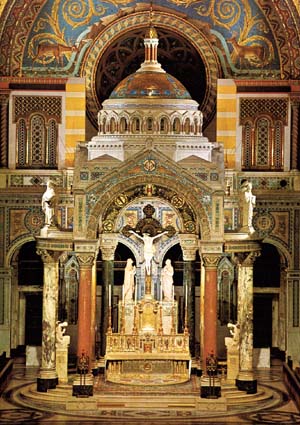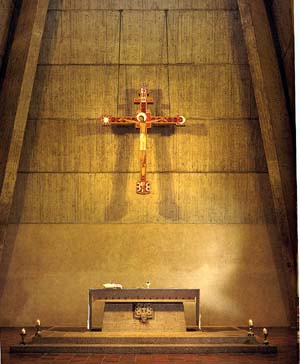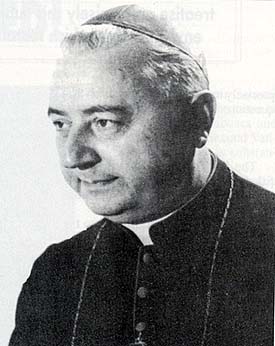 |
A Column of Catholic Orientation
The New Mass:
A Flavor of Protestantism
Marian T. Horvat
“What’s wrong with the New Mass? I like the Old Mass and know it is better, but don’t know how to explain this to my children, who prefer the Novus Ordo because they say they understand it better.”
This was a question Jan put to me.
Let me begin my response with a revealing statistic that shows that the New Mass is not easier to understand.
In a recent article in Our Sunday Visitor, Russell Shaw draws attention to a serious problem: Mass attendance has halved in the last four decades since Vatican II. (1) How can this be, he asks, when all changes in the Church were made in the name of making the Mass more appealing to the people – changing it from Latin to English, turning the altars around, involving the laity with dialogue and activities, permitting popular songs and guitars?
His answer was that people don’t attend Mass because they don’t know what it really is. He is right about that. A 1992 Gallup poll showed that 70 % of Catholics who attend the Novus Ordo Mass do not believe they are receiving the Body and Blood, Soul and Divinity of Our Lord Jesus Christ, under the appearance of bread and wine, at Holy Communion. That is to say, only 30% believe in the Real Presence.
These shocking figures, which have not been contested or disproved, divulge what conservatives like Shaw refuse to admit – the essential failure of the New Mass and the bad fruits of the conciliar adaptation to the modern world.
Supposedly, all the changes made in the name of Vatican II would make the Mass more understandable. In fact, however, fewer people today truly understand what the Holy Sacrifice of the Mass is, or have a completely different notion of what the Mass is about. And this seems to me the real problem – the Mass suffered significant changes that made it seem something different from what it really is.
Differences between the Traditional Mass and New Mass
Catholics always believed that the Sacrifice of Calvary is renewed on the altar at the Holy Mass. By means of the sacrificing priest, the bread and wine is changed into the very Body and Blood of Our Lord at the moment of the Consecration. The words that the priest says at this moment constitute the Transubstantiation, a change of substance.

Above, the Cathedral of St. Louis fits perfectly with the grandiose Sacrifice which is renewed at the Mass.
Below, in the Abbey of St. Anne (Kergonan, France), a cold emptiness in worship is the result of the conciliar reformers' intention to please Protestants
 |
Quite different from this elevated notion of the Mass, the New Mass represents a shocking liturgical revolution similar to the Pseudo-Reformation of Luther and other Protestants.
Here are some keynotes of the New Mass that give it a Protestant tone:
• The abolition of the sacrificial character of the Mass – We have a man-made liturgy in which mention of the Sacrifice of Calvary has been insistently removed, as well as any sacrificial tone, and only the notions of praise and thanksgiving retained. Even the altar, which was turned toward Jerusalem reminding us of the sacrifice of Christ to God, was replaced by a table in order to emphasize the new notion that the Mass is mainly a banquet, and not a sacrifice.
• An emphasis on the memorial supper – According to this new conception, the Mass is principally a Communion service – a memorial of the Lord’s supper, a Protestant thesis emphasized by Luther in the 16th century. As Luther clearly stated, “The mass is not a sacrifice but a thanksgiving to God and a communion with believers.” (2)
• The priesthood of the faithful – The so-called priesthood of the faithful was over-emphasized and causes confusion with the sacramental priesthood. Catholic teaching is that it is the priest, and the priest alone, who is necessary for the Mass to be effective. To the contrary, the New Mass promotes the idea that the priest is a mere delegate of the assembly, and the people are an essential part of the “celebration.”
In fact, the General Instruction on the Novus Ordo states that the “people of God” celebrates the rite with the “priest-presider.” This equality between the priest and the faithful is what the Protestant leaders taught when they defended that the celebration of the “Lord’s supper” is realized jointly by the priest and the people.
What is the main difference, then, between the Traditional Mass and the New Mass? The traditional Latin Mass is the clear expression of Catholic teaching, which understands the Mass as the re-enactment of the Sacrifice of Calvary. The New Mass was made to please Protestants, and for this purpose:
1. suppressed the sacrificial character of the Mass, denied by Protestants,
2. emphasized the Mass as a memorial and a banquet, as preached by Protestants,
3. stressed the role of the people as essential to the “celebration of the Eucharist,” also defended by Protestants.
The makers of the New Mass definitively wanted to favor Protestantism
There is the false notion many Catholics have that the New Order Mass is just a simple translation of the traditional Latin rite, with a few small changes here and there. This is not true. It is a re-write, and quite substantial one, undertaken by a commission set up by Paul VI to implement the Council’s teaching on the liturgy. (3)
The commission was headed by the Progressivist Fr. Anibale Bugnini and included six Protestants. Therefore, the commission that threw overboard the ancient Latin rite and centuries of accumulated Catholic tradition, and made up a brand new one, was headed by a Progressivist and included Protestants.

Fr. Bugnini, the principal designer of the New Mass | |
Their intentions? Dr. Smith, one of the Lutheran representatives at this commission, later publicly boasted, “We have finished the work that Martin Luther began.” And Fr. Bugnini stated that his aim in designing the New Mass was “to strip from our Catholic prayers and from the Catholic liturgy everything which can be the shadow of a stumbling block for our separated brethren, that is, for the Protestants.” (4)
A clear design to destroy the Mass
The designers of the New Mass have boasted endlessly on the novelty and revolutionary nature of their creation, and you can find many examples. I will only site one: Fr. Joseph Gelineau, SJ, one of the Catholic experts involved in its formulation, stated: “This needs to be said without ambiguity: the Roman Rite as we knew it no longer exists. It has been destroyed." (5)
The critics have said essentially the same thing. Again, I will just cite one. Cardinal Alfredo Ottaviani, who served as head of the Holy Office under three Popes, wrote that "the Novus Ordo Missae .... represents a striking departure from the Catholic theology of the Holy Mass as it was formulated in the Council of Trent,” and that there are “implicit denials of Christ’s Real Presence and the doctrine of Transubstantiation.” (6)
Based on these testimonies, as well as on the fact that the religious authorities have imposed that this New Mass be said everywhere, is it any wonder that so many Catholics today do not believe in the Real Presence?
1. August 24, 2003.
2. Roland H. Bainton, Here I Stand (Nashville: Abingdon Press, 1950), p. 202.
3. The ambiguous language of the Constitution Sacrosanctum Concilium, the official document of Vatican II that deals with liturgy, is set out in Atila S. Guimarães’ In the Murky Waters of Vatican II, pp. 229-31.
4. L'Osservatore Romano, March 19, 1965.
5. Joseph Gelineau, S.J., Demain la liturgie (Paris: Ed. du Cerf, 1979), p.10.
6. Modern History Sourcebook: The Ottaviani Intervention, 1969, online edition.

Posted on September 23, 2003
|
Talks with Jan | Religious | Home | Books | CDs | Search | Contact Us | Donate

© 2002-
Tradition in Action, Inc. All Rights Reserved
|
 |
|